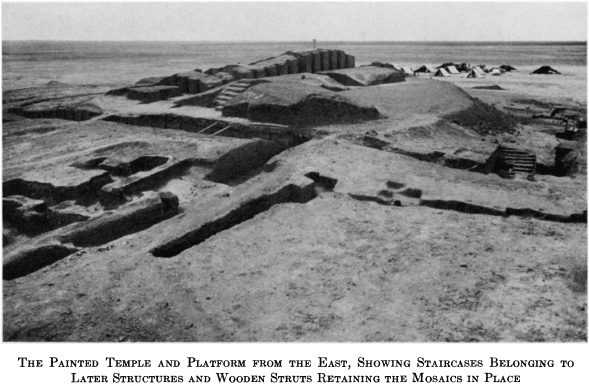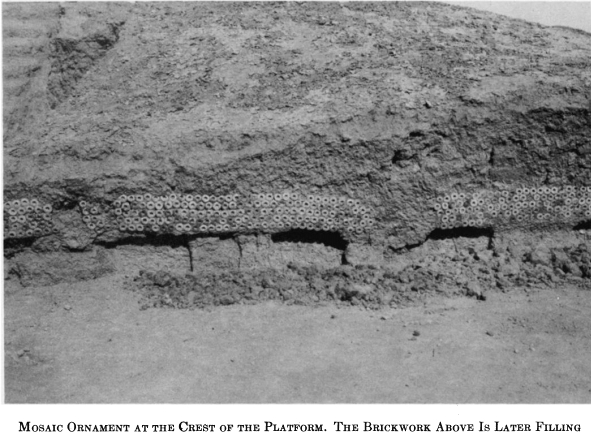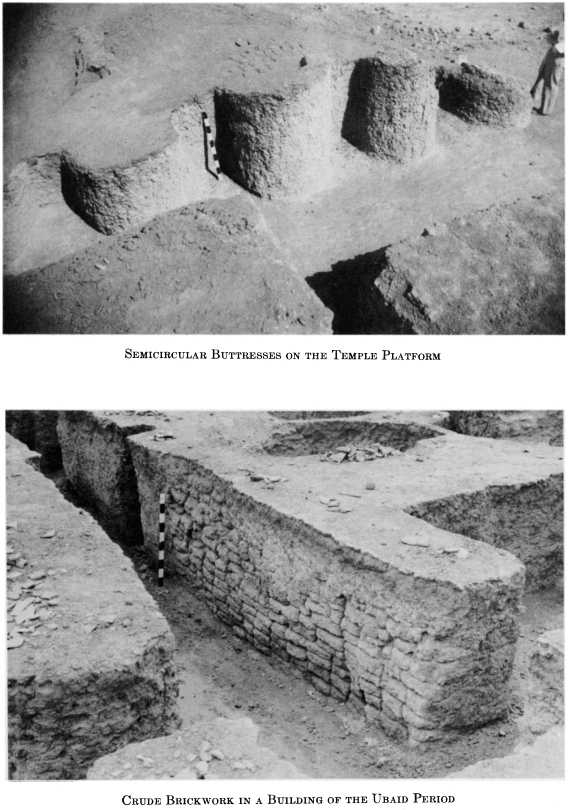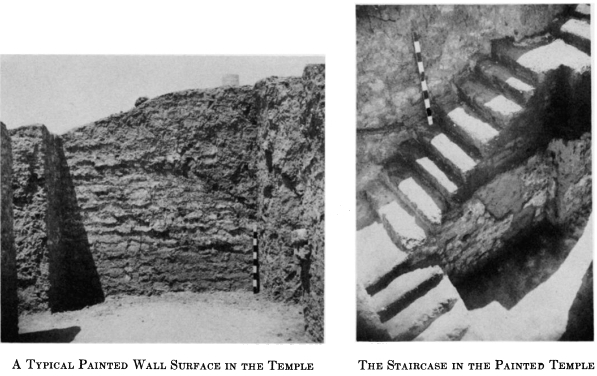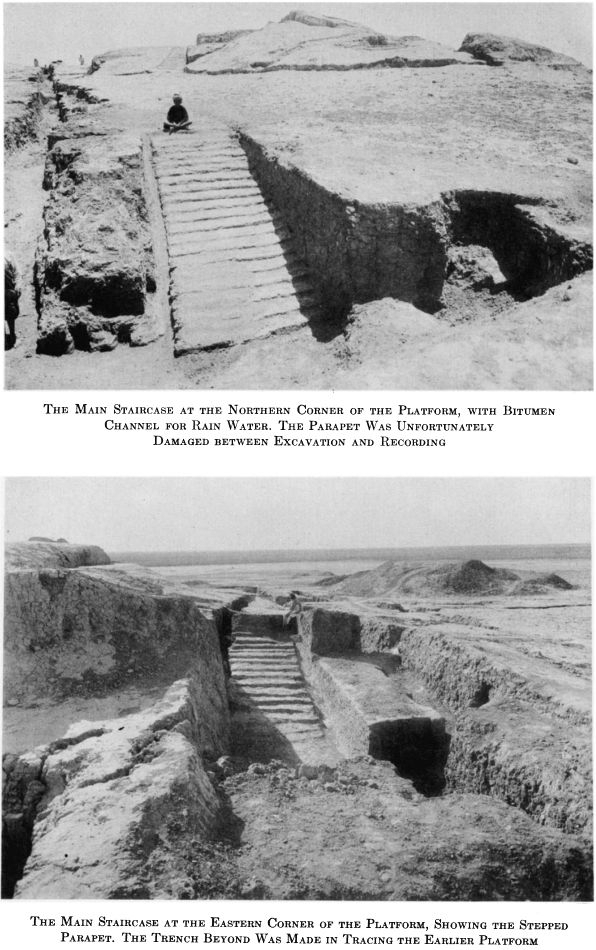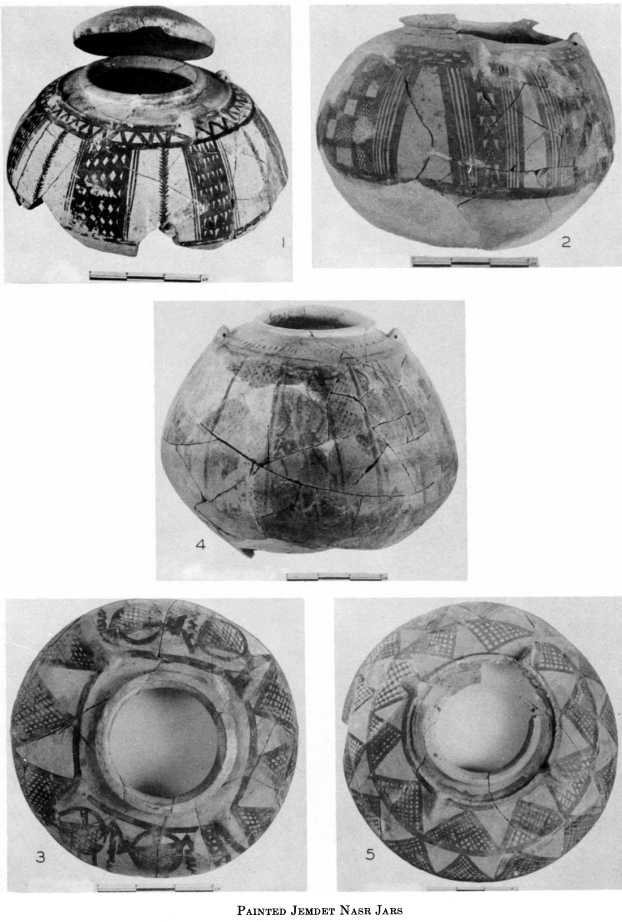|
Other Archaeological Sites / The Neolithic of the Levant (500 Page Book Online) Pre-Historic Tell Uqair in Mesopotamia (Iraq)
A tell (mound) site 80 kilometers south of Baghdad excavated by an Iraqi team in the early 1940s. These excavations uncovered a settlement of the Ubaid Period and a temple of the Uruk Period. This temple has a tripartite plan and is very similar to the White Temple in the Anu sanctuary at Uruk itself. lt is distinguished by the occurrence of fine polychrome wall paintings with human and animal figures. Fish offerings suggest that this temple might have been dedicated to Enki. A small subsidiary chapel later in date than the temple itself contained a fine collection of pots of Jemdet Nasr style and four clay tablets inscribed with pictographic symbols of the kind in use in the Jemdet Nasr Period (AHSFC).
Tell Uqair: Excavations by the Iraq Government Directorate of Antiquities in 1940 and 1941 ... Within sight of Tell Ibrahim to the north is a group of much smaller mounds, the most prominent of which is Tell Uqair. Interest in Tell Uqair resulted from the normal routine of inspection work by the Directorate of Antiquities. A collection of surface finds submitted to the Museum included painted pottery of the Ubaid period in the first half of the fourth millennium B.C. and also fragments of clay-cone mosaic ornament of the type now usually associated with public buildings of the pre-dynastic era. This combined evidence seemed to justify at least a sondage at Tell Uqair and for this purpose a sum of money was put aside by the Directorate of Antiquities. Excavations were begun in March 1940 with these results: (1) the remains of a temple and temple platform of the Uruk period had been excavated in the northern mound and the frescoes in the temple were exposed and copied; (2) a small subsidiary chapel adjoining the platform on the southeast side had yielded a surprisingly fine collection of painted pottery of the Jemdet Nasr period as well as some contemporary inscribed tablets; (3) on the outer slope of the northern mound a settlement of the Ubaid period had been found, several buildings excavated and a sounding carried down to virgin soil; (4) finally in the southern mound a number of fairly rich graves had been encountered suggesting a cemetery of the Early Dynastic period ...
Ever since Eduard Meyer published in 1906 his Sumerier und Semiten in Babylonien early Mesopotamian history has been understood as a changing equilibrium between two different peoples ending in the lasting predominance of the Akkadians ... It is only by the middle of the third millennium that the Akkadians are recognizable as an element in the population; (1)speaking a known language (2)imposing a form of kingship less shackled by the particularism of the city states and (3)affecting religion in a manner which can perhaps be understood as a reinterpretation of native beliefs by Westerners inured in a different view of the universe. But the interplay of forces is much more complicated than we had believed. Professor Thorkild Jacobsen has shown that the change was never experienced as a racial conflict or as a shift from native to foreign rule. (1). There is nowhere a sudden break. Even the change in the language cuts across historical divisions. It seems that at Mari and probably also at Khafajah, Akkadian was spoken and written within the framework of the Early Dynastic civilization. Yet this civilization is strikingly homogeneous from Eridu in the south up to Assur and Mari and it had been considered solidly “Sumerian” on the strength of the numerous texts found in the southern part of the country at Fara -- Tello and Ur. It is clear therefore that even when considering the third millennium B.C. an automatic appeal to the contrast between Sumerians and Akkadians entirely misses the point. The only tangible contrast is that of language. It is so profound that it suggests a corresponding difference in mentality. To trace this difference through the gradual changes coinciding with the increasing predominance of Semitic-speaking people in Mesopotamia remains a task to be undertaken and one which requires great tact and subtlety of perception. For the earlier periods there is very little evidence bearing on this problem. The earliest written texts from Warka seem to be Sumerian; in important matters such as the appointment of sacred buildings there is continuity. It is therefore tempting to assert that the Sumerians prevailed unchallenged in the country and that their gradual submergence by immigrants from the west is a process belonging to the third millennium. But this view implies a long period of undisturbed existence previous to the penetration of the Akkadians into the plain, a view unsupported by anything observed in later times and directly conflicting with the changes in material culture which we ob- serve in the Ubaid, the Uruk and the Jemdet Nasr periods. A continuation of work at Tell Uqair should provide us with a succession of remains completely covering the transition from prehistoric to protohistoric times ... In dealing with the periods preceding Early Dynastic times the notion of being either Sumerian or Akkadian evaporize. At the present stage of our knowledge it simply is not practicable to apply these names to the earliest phases of Mesopotamian culture ...
(1) The Assumed Conflict between Sumerians and Semites in Early Mesopotamian History
|
